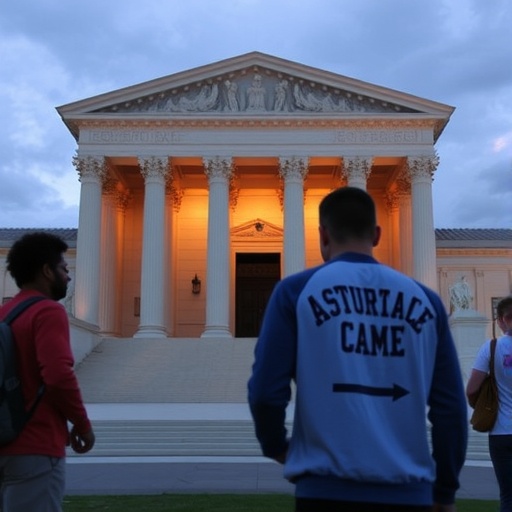Supreme Court Set to Rule on Idaho’s Transgender Sports Ban: A Pivotal Fight for Equal Protection in Youth Athletics
In a decision that could reshape the landscape of youth sports across America, the U.S. Supreme Court has agreed to hear arguments in a high-stakes challenge to Idaho’s controversial ban on transgender athletes competing in events aligned with their gender identity. Announced on Monday, the case centers on a 2020 state law that prohibits transgender girls and women from participating in female sports categories, igniting fierce debates over fairness, inclusion, and constitutional rights. With similar sports bans now in place in more than 24 states—over half the nation—this ruling could establish a national precedent, affecting millions of student-athletes and testing the boundaries of equal protection under the 14th Amendment.
- Idaho’s Fairness in Women’s Sports Act: The Law at the Heart of the Controversy
- Plaintiffs’ Stories: Transgender Teens Denied Their Shot at the Track
- Clashing Legal Arguments: Equal Protection vs. Biological Distinctions
- Waves of Similar Bans: How Idaho’s Law Echoes Nationwide
- Potential Outcomes: Reshaping Transgender Athlete Rights and Beyond
The case, known as B.P.J. v. West Valley School District, stems from the experiences of two transgender girls in Idaho who were barred from joining their high school track teams. Their fight highlights a growing tension between state-level restrictions and federal protections for transgender youth, drawing support from civil rights organizations and opposition from conservative groups advocating for what they call “biological fairness.” As the Supreme Court prepares for oral arguments in early 2024, the nation watches closely, knowing the outcome could either affirm or dismantle a wave of legislation targeting transgender athletes.
Idaho’s Fairness in Women’s Sports Act: The Law at the Heart of the Controversy
Idaho’s sports ban, formally titled the Fairness in Women’s Sports Act, was signed into law by Governor Brad Little in March 2020, making it the first state to enact such a measure. The legislation requires student-athletes to compete based on their sex assigned at birth, effectively sidelining transgender students like the plaintiffs who have undergone hormone therapy and identify as female. Proponents, including the bill’s sponsor, Republican state Rep. Barbara Ehardt, argue that the law protects cisgender female athletes from what they perceive as an unfair physical advantage held by transgender competitors.
“This is about preserving opportunities for girls who have fought for Title IX equality for decades,” Ehardt stated in a 2020 interview with local media. Title IX, the 1972 federal law prohibiting sex-based discrimination in education, has been a cornerstone for women’s sports participation, which has surged from fewer than 30,000 high school athletes in 1971 to over 3.5 million today, according to the National Federation of State High School Associations.
However, critics contend that the Idaho law discriminates against transgender students, violating equal protection clauses by imposing arbitrary barriers to participation. Data from the Williams Institute at UCLA estimates that about 300,000 transgender youth aged 13-17 live in the U.S., with roughly 1.8% of high school students identifying as transgender. In Idaho alone, advocates say fewer than a dozen transgender athletes are affected, underscoring the law’s broad impact on a small but vulnerable population.
The ban’s enforcement has led to immediate fallout. Schools risk losing state funding if they allow transgender athletes to compete, and individual athletes can face civil penalties. This has prompted lawsuits from groups like the ACLU, which represents the plaintiffs and argues that the law inflicts psychological harm, with studies from the American Academy of Pediatrics linking sports exclusion to higher rates of depression and suicide among transgender youth—rates that are already four times the national average.
Plaintiffs’ Stories: Transgender Teens Denied Their Shot at the Track
At the core of the Supreme Court case are two Idaho high school students, referred to pseudonymously as B.P.J. and Lindsay Hecox. B.P.J., a transgender girl who began her medical transition at age 13, dreamed of joining her school’s cross-country team but was blocked by the ban just months after its passage. “Running isn’t just a sport for me; it’s where I feel most myself,” B.P.J. shared in an affidavit filed with the court. Now in her early 20s, she has pursued higher education but carries the emotional scars of exclusion.
Lindsay Hecox, the other plaintiff and a cisgender woman, sued alongside B.P.J. not as a transgender athlete but as an ally challenging the law’s overreach. A former college runner, Hecox testified that the ban doesn’t enhance fairness but instead polices women’s bodies unnecessarily. “I’ve competed against athletes of all backgrounds, and no one-size-fits-all rule like this solves anything,” she told reporters outside the federal courthouse in Boise in 2021.
Their legal battle began in U.S. District Court, where a judge issued a preliminary injunction in 2020, halting enforcement of the ban. The 9th U.S. Circuit Court of Appeals upheld this in 2023, ruling that the law likely violates equal protection by discriminating based on sex and transgender status. The state appealed to the Supreme Court, which granted certiorari in October 2023, bypassing further review in lower courts.
Supporting the plaintiffs are amicus briefs from over 50 organizations, including the NCAA, which has its own transgender inclusion policy allowing competition after a year of testosterone suppression. Statistics from the NCAA show that transgender athletes represent less than 1% of participants, and peer-reviewed studies in the British Journal of Sports Medicine indicate that after hormone therapy, transgender women do not retain significant advantages in most sports.
Clashing Legal Arguments: Equal Protection vs. Biological Distinctions
The Supreme Court’s review will hinge on whether Idaho’s sports ban withstands scrutiny under the Equal Protection Clause of the 14th Amendment, which mandates that states treat similarly situated individuals alike. Lawyers for the plaintiffs argue that the law imposes heightened scrutiny as a form of sex discrimination, citing the 2020 Supreme Court decision in Bostock v. Clayton County, which extended workplace protections to transgender employees by ruling that discrimination based on gender identity is inherently sex-based.
“If firing someone for being transgender is sex discrimination, so is banning them from sports,” said Chase Strangio, ACLU deputy director for transgender rights, in a recent podcast interview. The plaintiffs’ brief emphasizes that the ban lacks a rational basis, pointing to evidence that transgender athletes on hormone therapy perform comparably to cisgender peers. For instance, a 2021 study by the Canadian Centre for Ethics in Sport reviewed 20+ research papers and found no blanket advantage for transgender women in elite sports post-transition.
Idaho’s defense, led by state Attorney General Raúl Labrador, counters that the law promotes a legitimate government interest in ensuring fair and safe competition for women. They invoke intermediate scrutiny, arguing that biological differences—such as muscle mass and bone density—justify the classification. “The state has a compelling interest in protecting women’s sports from erosion,” Labrador’s office wrote in their petition to the Court.
Conservative advocates, including the Alliance Defending Freedom, have filed briefs supporting Idaho, claiming that allowing transgender athletes undermines Title IX. They reference cases like Franklin v. Gwinnett County Public Schools (1992), where the Court upheld remedies for Title IX violations. Yet, opponents highlight that no credible evidence shows transgender participation harming cisgender athletes; in fact, a 2022 report from the U.S. Department of Education notes that transgender inclusion policies in states without bans have not reduced opportunities for girls’ sports.
The ideological split on the Court adds intrigue. Justices like Sonia Sotomayor and Elena Kagan, known for progressive stances on LGBTQ+ rights, may push for strict scrutiny, while conservatives like Clarence Thomas and Samuel Alito have historically favored state autonomy in social issues. Justice Amy Coney Barrett’s swing vote could be pivotal, given her nuanced approach in recent equal protection cases.
Waves of Similar Bans: How Idaho’s Law Echoes Nationwide
Idaho’s sports ban is no outlier; it’s part of a broader legislative trend targeting transgender rights. Since 2020, at least 24 states have enacted laws restricting transgender athletes, with Florida, Texas, and Arkansas among the most aggressive. In Texas, Governor Greg Abbott’s 2021 executive order directed the University Interscholastic League to enforce birth-sex rules, leading to over 20 school districts defying the mandate and facing state investigations.
These laws often mirror Idaho’s language, citing “fairness” and “safety,” but data tells a different story. The Movement Advancement Project tracks that transgender youth in states with bans face 2.5 times higher barriers to extracurricular activities, correlating with dropout rates 15% above the national average. Conversely, inclusive states like California report thriving transgender athlete participation without incident—Lia Thomas, the transgender swimmer who won an NCAA title in 2022, competed under established protocols and sparked debate but no widespread displacement.
Nationally, the bans coincide with over 500 anti-trans bills introduced in 2023 alone, per the ACLU. Sports restrictions are just one facet; others target healthcare and bathroom access. Public opinion is divided: A 2023 Gallup poll shows 69% of Americans oppose transgender athletes in women’s sports, but support drops to 45% when informed about hormone therapy effects. This polarization fuels the Supreme Court’s urgency, as lower courts issue conflicting rulings—upholding bans in West Virginia but striking them down in Connecticut.
International context adds weight. The International Olympic Committee updated its framework in 2021 to defer to individual sports bodies, emphasizing inclusion without advantage. If the U.S. Supreme Court sides with the plaintiffs, it could harmonize American policy with global standards, potentially influencing youth sports governance through organizations like the NFHS.
Potential Outcomes: Reshaping Transgender Athlete Rights and Beyond
As oral arguments loom in the spring of 2024, the Supreme Court’s decision—expected by summer—could ripple far beyond Idaho. A ruling upholding the ban would validate state experiments, likely accelerating similar laws in holdout states like New York and Illinois, where Democratic majorities have resisted. This might embolden challenges to other transgender protections, testing the Bostock precedent in educational contexts.
Conversely, striking down the law would affirm equal protection for transgender athletes, mandating inclusive policies nationwide. Schools and leagues would need to revise guidelines, possibly adopting NCAA-style hormone requirements. Experts predict this could boost participation rates for all students; a 2022 GLSEN survey found that 85% of transgender youth want to play sports but fear discrimination.
Beyond athletics, the case intersects with ongoing battles over gender-affirming care. With the Court already docketed to hear challenges to state bans on youth transitions, a pro-inclusion stance here could signal broader support for LGBTQ+ rights. Organizations like Lambda Legal warn of a “slippery slope,” where sports exclusions pave the way for further marginalization.
Stakeholders are mobilizing. The Biden administration has filed a brief supporting the plaintiffs, urging the Court to recognize transgender status as protected under equal protection. Meanwhile, GOP-led states are watching closely, with attorneys general from 15 states backing Idaho. As the justices deliberate, one thing is clear: This case isn’t just about sports—it’s a referendum on equality in an era of division.
For transgender youth like those in Idaho, the wait is personal. “I just want to run without someone deciding who I am,” B.P.J. reflected in a recent op-ed. The Supreme Court’s gavel could open doors or slam them shut, defining the future of fair play for generations to come.










